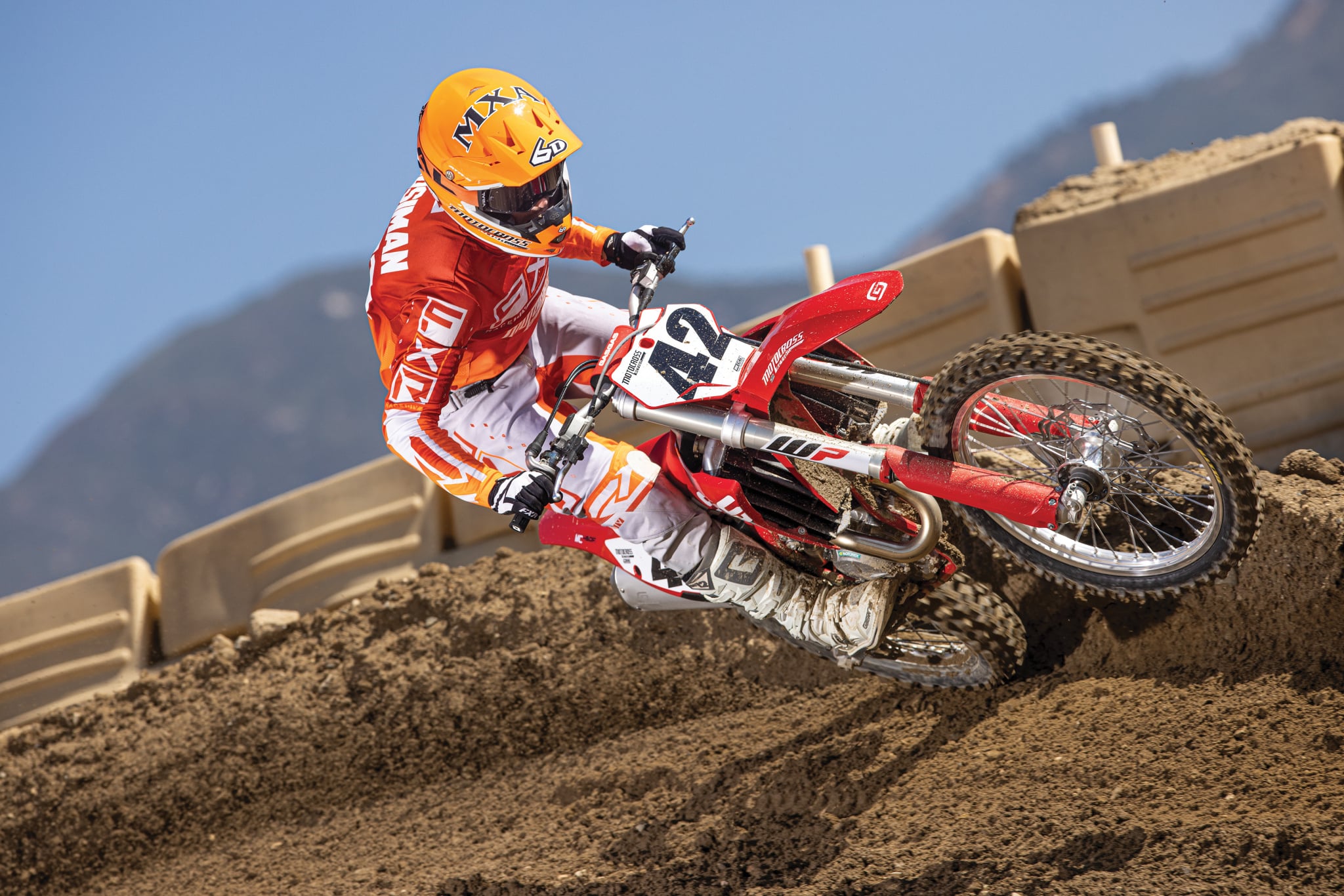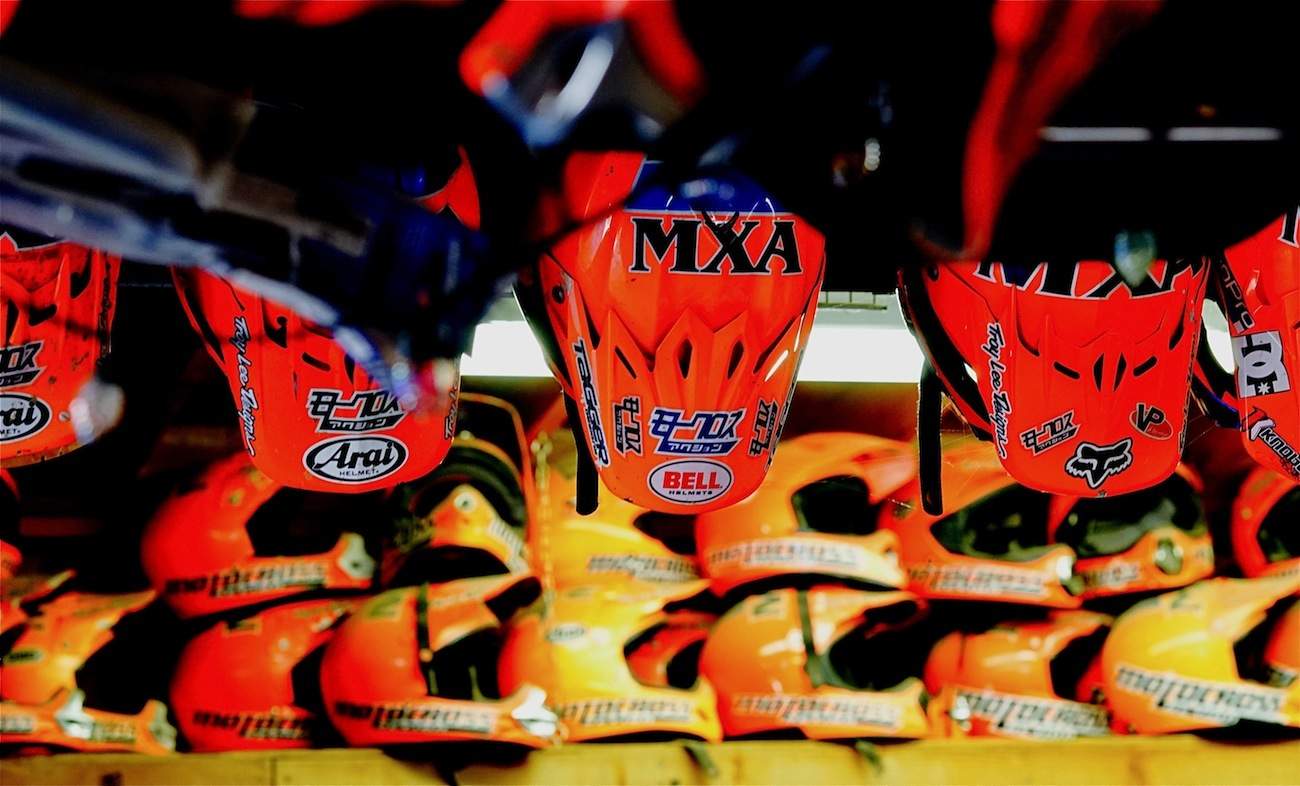TEN THINGS YOU NEED TO KNOW ABOUT MXA BIKE TESTS
 MXA has several layers of test riders. Layer one is the four full-time MXA test riders. Typically, Jody Weisel, Josh Mosiman, Dennis Stapleton and Josh Fout. Layer two consists of special test riders who are on-call when we need their expertise in photo shoots, more hands on deck for shootouts or more experience with specific brands and models. The third layer is made up of the endurance test riders. They rarely appear in photos, apart from race coverage, but they are experienced racers (not necessarily pros), who race MXA’s test bikes every week. They switch bikes at regular intervals to insure that every test bike gets enough time on the its hour meter to test its reliability.
MXA has several layers of test riders. Layer one is the four full-time MXA test riders. Typically, Jody Weisel, Josh Mosiman, Dennis Stapleton and Josh Fout. Layer two consists of special test riders who are on-call when we need their expertise in photo shoots, more hands on deck for shootouts or more experience with specific brands and models. The third layer is made up of the endurance test riders. They rarely appear in photos, apart from race coverage, but they are experienced racers (not necessarily pros), who race MXA’s test bikes every week. They switch bikes at regular intervals to insure that every test bike gets enough time on the its hour meter to test its reliability.
(1) 72,059. Using the average result from MXA bike tests, between the MXA staffers and a few freelance contributors, our photographers hit the trigger 72,059 times to capture the content for 12 issues of Motocross Action Magazine. That constitutes 576 gigabytes of data (which is more memory than Neil Armstrong’s moon lander had) that is stored and backed up on MXA’s servers. Only 1/45th of those photos actually made it into the magazine.
(2) 1636. Through 12 issues of Motocross Action Magazine only 1636 photos were used in the magazine out of the 72,059 that were snapped by our photographers. It’s not that our photographers use the spray-and-pray method of shooting photos; it’s just that they make sure to get every possible angle. When we sit down to layout the next issue, some shots just work better than others.
(3) 66. On average, the MXA wrecking crew tests and writes full reviews on 66 different machines every year. That averages out to 5.5 bikes per month. Out of those 66 bikes, eight were full-factory bikes. Twenty-three were project bikes that either MXA built or someone built for us. Within the year, we tested all of that year’s new model bikes as well as some of the next year’s bikes at the end of the year for a total number of 35 new model bike tests. Not bad for a year’s worth of work. When Ducati rolls down the assembly line as a 2026 models, our workload will increase
(4) 19. We took the 66 bikes we tested and rode them at 19 different racetracks scattered around the country, including Europe, Japan, Florida, Texas, South Carolina, Arizona or any one of the ten race track that we frequent (both public and private). This helps us understand how bikes run and handle in different terrain, weather and altitudes. We test and ride at many different tracks, but our go-to “dirt dyno” is Glen Helen Raceway. It has three different race tracks, a couple Supercross tracks and miles of off-road trails. We offers us world class track to use for repeatable and consistent comparisons. Plus, it has big, long, fast straights, gigantic uphills and downhills and a rough and rutty layout that tests the mettle of man and machine. It has hosted everything from AMA Nationals to MXGP races to the World Two-Stroke Championship to the World Vet Championship to four different local races every weekend and is used as a test track by every manufacturer’s R&D teams.
 Even the numbers on the test bikes are coded to tell us the model year and the brand and the gear we use for the photos are often color-coded to make the rider and gear standout—in this case: Jersey: FXR Racing Podium Pro, Pants: FXR Racing Podium Pro, Helmet: 6D ATR-2, Goggles: Viral Brand Works series, Boots: Gaerne SG-12.
Even the numbers on the test bikes are coded to tell us the model year and the brand and the gear we use for the photos are often color-coded to make the rider and gear standout—in this case: Jersey: FXR Racing Podium Pro, Pants: FXR Racing Podium Pro, Helmet: 6D ATR-2, Goggles: Viral Brand Works series, Boots: Gaerne SG-12.
(5) 72. For each bike MXA tests, studio photos of the test bike, followed by an action shoot and the video shoot takes place with one of our photo riders for the magazine, website and YouTube channel. If you haven’t noticed, the test riders wear new sets of gear for each shoot. That adds up to 66 new sets of gear in a year. Not only is the gear new, but we virtually never run the same color gear twice. So, why did we write the number 72 at the start of this paragraph? The other 6 sets of gear were used for product tests, shootouts and as replacements.
(6) 35. MXA is in the business of testing the best and worst products on the market. In an average year the wrecking crew tests 35 different exhaust systems on an assortment of different bikes and in pipe shootouts. Some are good, others great and a few horrible. For many of the different test pipes, the wrecking crew had a hand in the development process — by rejecting prototype pipes until they were redesigned.
(7) 27. There was once a time when the must popular boot colors were black and white. Since black doesn’t photograph well, MXA almost always uses white boots. Not many companies made more than the two colors anyway in the past. In the last few years, however, boot companies such as Gaerne, Alpinestars and Sidi have broken the mold of the plain Jane white-and-black boots by offering bold and bright colors. So, instead of just having one or two pairs of white boots from each company, we went through a total of 27 different boots of all different color ways in 2015.
(8) 17. Although there are hundreds of orange helmets in the MXA arsenal, the majority of them are retired to the rafters of Jody’s barn. We don’t use a helmet after it has been crashed, but instead replace it with a new one. We have multiples of each helmet brand, although we rotate them to keep them looking fresh for photos.
(9) 59. For each photo shoot, we want our riders to look their best. Not only do they wear new gear, but for each shoot they have a new set of goggles as well. Last year, our test riders used 59 pairs of goggles for photo shoots only. If the goggle still looked new after a single use, we used it again, but rarely for a third time.
(10) 1000. With all the riding that the wrecking crew does, we go through a lot of gasoline. On average, we burn through 20 gallons of gas per week for test sessions (and even more for weekly racing). Our test gas usage equals 1000 gallons per year and SoCal’s current price for 91-octane gas is $5.45 a gallon. The majority of the 5450 gallons of gas we use is 91 octane pump gas, although in some of the project bikes and two-strokes we run either straight race gas or a 50/50 blend of race gas and pump gas to keep the bikes running smoothly. If we need race fuel for a test bike, we use VP or ETS Racing Fuel for consistency.









Comments are closed.